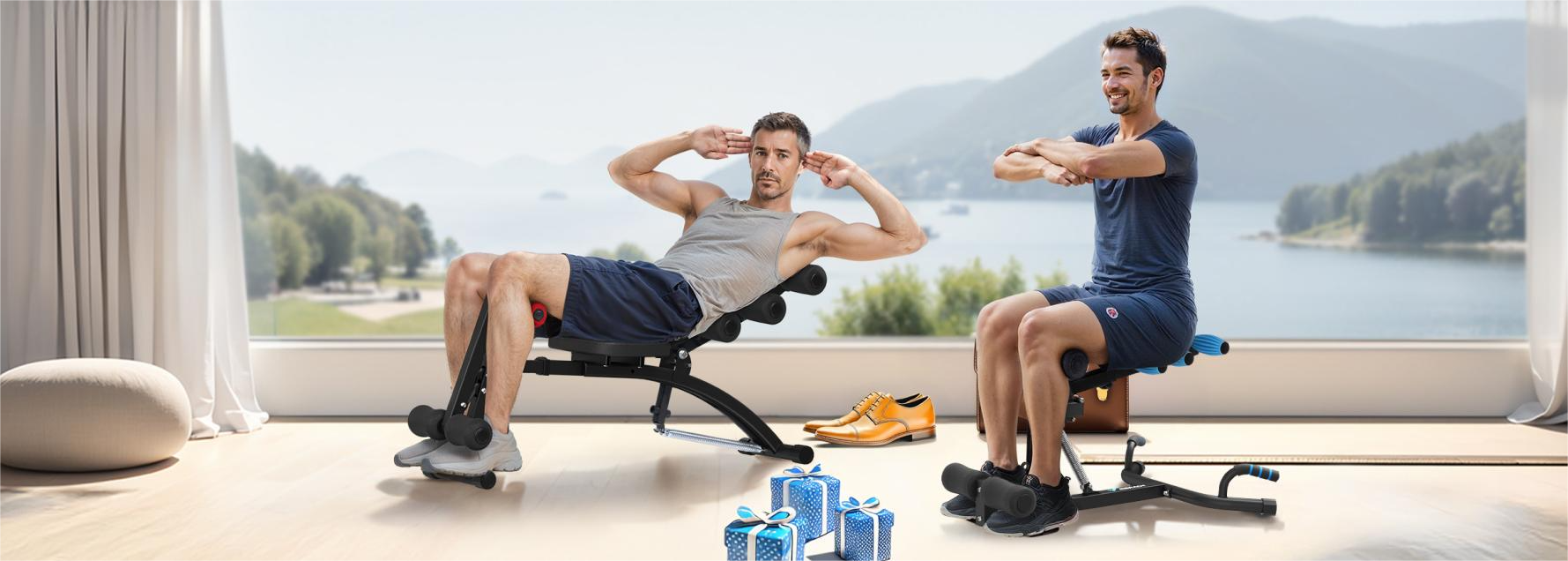Let's face it—different fitness goals need different approaches. The workout that helps your friend lose weight might not be the best choice if you're trying to build muscle. And someone training for a marathon needs a completely different plan than someone trying to get stronger.
In this straight-talking guide, we'll break down exactly how to train for three common fitness goals: weight loss, muscle gain, and endurance. No complicated jargon, just practical advice you can start using today.
Weight Loss: Training to Shed Pounds
Losing weight comes down to burning more calories than you eat, but the right training approach can make this process much more effective and enjoyable.
What Actually Works for Weight Loss
The best weight loss training combines three key elements:
- Strength training to preserve muscle
- High-calorie-burning cardio sessions
- Increased daily movement (not just workouts)
Let's talk about why this mix works better than just doing endless cardio.
Strength Training for Weight Loss
Many people think cardio is the only way to lose weight, but strength training is actually super important. Here's why:
- Keeps your metabolism high: Muscle burns more calories than fat, even when you're doing nothing
- Shapes your body: As you lose fat, muscle gives you the "toned" look most people want
- Prevents the "skinny-fat" look: Losing weight without strength training can leave you smaller but still soft
How to do it: Aim for 2-3 strength sessions per week, focusing on exercises that work multiple muscles at once.
Sample Weight Loss Strength Workout
Do this circuit 3 times, resting 60 seconds between circuits:
- Squats: 12-15 reps
- Push-ups: 10-12 reps (on knees if needed)
- Dumbbell rows: 12 reps per arm
- Lunges: 10 reps per leg
- Mountain climbers: 30 seconds
This type of workout burns calories during the session and keeps your metabolism elevated for hours afterward. You can make it harder over time by adding weight or doing more challenging versions of each exercise.
For home workouts, a versatile piece of equipment like a rowing machine can provide both strength and cardio benefits in one workout.
Cardio That Actually Burns Fat
Not all cardio is created equal when it comes to weight loss. Here are the most effective approaches:
HIIT (High-Intensity Interval Training)
HIIT alternates between short bursts of intense effort and brief recovery periods. It's great for weight loss because:
- Burns more calories in less time than steady-state cardio
- Creates an "afterburn effect" where you keep burning extra calories for hours
- Preserves muscle better than long, slow cardio sessions
How to do it: Try 20-30 second all-out efforts followed by 40-60 seconds of recovery, repeated 8-12 times.
Sample HIIT Workout
Warm up for 5 minutes, then:
- Sprint for 30 seconds
- Walk for 60 seconds
- Repeat 8-10 times
- Cool down for 5 minutes
Total time: About 25 minutes
Don't have space to run? An exercise bike works great for HIIT workouts at home, letting you quickly switch between high and low intensities.
Moderate-Intensity Steady State (MISS)
While HIIT is super effective, longer moderate sessions still have their place:
- Easier to recover from than HIIT
- Burns significant calories during longer sessions
- Less mentally demanding than intense intervals
How to do it: 30-45 minutes at a pace where you're breathing harder but could still hold a conversation.
A recumbent bike is perfect for comfortable longer cardio sessions, especially if you have joint issues or back pain.
The Weight Loss Training Schedule
Here's a simple weekly plan that balances all these elements:
- Monday: Strength training (full body)
- Tuesday: HIIT cardio (20-25 minutes)
- Wednesday: Active recovery (walk, yoga, or light activity)
- Thursday: Strength training (full body)
- Friday: Moderate-intensity cardio (30-45 minutes)
- Saturday: Strength training (full body)
- Sunday: Rest or active recovery
Pro tip: The best workout plan is one you'll actually stick with. If you hate running, don't force yourself to run—find something you enjoy. Maybe it's dancing, swimming, or using an elliptical trainer while watching your favorite show.
Beyond Workouts
What you do outside your workout sessions matters just as much for weight loss:
- Get your steps in: Aim for 8,000-10,000 steps daily
- Take the stairs instead of the elevator
- Park further away from entrances
- Stand up and move for 5 minutes every hour if you have a desk job
These small changes add up to hundreds of extra calories burned each day!
Muscle Gain: Training to Build Size and Strength
Building muscle requires a completely different approach than losing weight. You need to focus on progressive overload—gradually challenging your muscles more over time—along with enough calories and recovery to support growth.
The Key Principles of Muscle-Building Training
- Progressive overload: Gradually increasing weight, reps, or sets
- Sufficient volume: Enough total work to stimulate growth
- Appropriate frequency: Training each muscle group 2-3 times per week
- Recovery time: Allowing muscles to repair and grow
Let's look at how to put these into practice.
The Best Training Split for Muscle Gain
For most people, either an upper/lower split or a push/pull/legs split works great for building muscle:
Upper/Lower Split (4 days per week)
- Monday: Upper Body
- Tuesday: Lower Body
- Wednesday: Rest
- Thursday: Upper Body
- Friday: Lower Body
- Saturday/Sunday: Rest
This setup hits each muscle group twice weekly with enough recovery time between sessions.
Push/Pull/Legs Split (6 days per week)
- Monday: Push (chest, shoulders, triceps)
- Tuesday: Pull (back, biceps)
- Wednesday: Legs
- Thursday: Push
- Friday: Pull
- Saturday: Legs
- Sunday: Rest
This more advanced split works well for people who can recover quickly and want to maximize muscle gain.
Rep Ranges for Muscle Growth
For the best muscle growth:
- Main compound exercises: 5-10 reps per set
- Isolation exercises: 10-15 reps per set
- Sets per exercise: 3-5
- Rest between sets: 1-3 minutes
The sweet spot for muscle growth is typically 10-20 total sets per muscle group per week.
Sample Muscle-Building Workout
Warm up with 5 minutes of light cardio and dynamic stretches, then:
- Bench Press: 4 sets of 6-8 reps
- Bent-Over Rows: 4 sets of 8-10 reps
- Overhead Press: 3 sets of 8-10 reps
- Pull-Ups or Lat Pulldowns: 3 sets of 8-12 reps
- Lateral Raises: 3 sets of 12-15 reps
- Tricep Pushdowns: 3 sets of 12-15 reps
- Bicep Curls: 3 sets of 12-15 reps
Sample Muscle-Building Workout
Warm up with 5 minutes of light cardio and dynamic stretches, then:
- Squats: 4 sets of 6-8 reps
- Romanian Deadlifts: 4 sets of 8-10 reps
- Lunges: 3 sets of 10-12 reps per leg
- Leg Press: 3 sets of 10-12 reps
- Leg Curls: 3 sets of 12-15 reps
- Calf Raises: 4 sets of 15-20 reps
Progressive Overload
Your muscles adapt to whatever stress you put on them. To keep growing, you need to keep challenging them by:
- Adding weight when you can complete all reps with good form
- Adding reps before increasing weight
- Adding sets to increase total volume
- Decreasing rest time between sets (but not below 60 seconds for main lifts)
Track your workouts in a notebook or app so you can see your progress and know when to push harder.
Cardio for Muscle Builders
Too much cardio can interfere with muscle growth, but some cardio is good for:
- Heart health
- Better recovery through improved blood flow
- Maintaining some conditioning
The right approach: 2-3 sessions of 20-30 minutes of low-intensity cardio per week, preferably on separate days from leg workouts.
A rowing machine is ideal for muscle builders because it provides a full-body workout without the joint impact of running.
Rest and Recovery
Remember: you don't grow during workouts—you grow during recovery. Make sure you:
- Sleep 7-9 hours each night
- Take at least 1-2 rest days per week
- Don't train the same muscle group two days in a row
- Listen to your body—if you're excessively sore or tired, take an extra rest day
Endurance Training
Whether you're training for your first 5K or aiming to improve your overall fitness, endurance training requires a strategic approach that builds your cardiovascular system and trains your body to go longer and stronger.
The Three Energy Systems
Endurance isn't just one thing—it involves three different energy systems:
- Aerobic system: Your main energy source for longer activities
- Lactate threshold: How hard you can go before fatigue rapidly increases
- VO2 max: Your maximum oxygen-processing capacity
Good endurance training targets all three.
Building Your Aerobic Base
The foundation of endurance is your aerobic base—your ability to sustain effort over time:
- What it is: Longer, easier sessions that build mitochondria (your cells' energy producers)
- How to do it: 30-90 minute sessions at a pace where you can still talk in full sentences
- How often: 2-4 times per week
Sample Base-Building Workout: 45-60 minutes of jogging, cycling, swimming, or using an elliptical machine at a comfortable pace where you're breathing harder but not gasping.
Threshold Training: Pushing Your Limits
To improve how long you can sustain harder efforts:
- What it is: Workouts at or slightly below the point where lactic acid accumulates
- How to do it: 20-30 minute sessions or intervals at a "comfortably hard" pace
- How often: 1-2 times per week
Sample Threshold Workout: After warming up, do 4 × 8 minutes at a pace that feels like a 7/10 effort (hard but sustainable), with 2 minutes of easy recovery between intervals.
An exercise bike is perfect for threshold training since you can precisely control your effort level without impact stress.
VO2 Max Intervals
To improve your maximum aerobic capacity:
- What it is: Short, intense intervals that get you breathing hard
- How to do it: 2-5 minute intervals at an effort that feels like 8-9/10
- How often: 1 time per week
Sample VO2 Max Workout: After warming up, do 5 × 3 minutes at hard effort (where talking is very difficult), with 3 minutes of easy recovery between intervals.
Endurance-Specific Strength Training
Contrary to what many think, strength training is super important for endurance athletes:
- Prevents injuries by strengthening supporting muscles
- Improves economy of movement
- Enhances power for hills or sprints
- Maintains muscle mass during high-volume training
How to do it: 1-2 full-body strength sessions per week, focusing on functional movements that support your endurance sport.
Sample Endurance-Supporting Strength Workout
Do 2-3 sets of each exercise with moderate weights:
- Squats: 10-12 reps
- Single-Leg Deadlifts: 10 reps per side
- Push-Ups: 10-15 reps
- Rows: 12-15 reps
- Planks: 30-60 seconds
- Lunges: 10 reps per leg
- Calf Raises: 15-20 reps
A Weekly Endurance Training Plan
Here's a balanced plan for someone building general endurance:
- Monday: Easy aerobic session (40-60 minutes)
- Tuesday: Strength training + short, easy cardio
- Wednesday: Threshold workout
- Thursday: Rest or very light activity
- Friday: Easy aerobic session (30-45 minutes)
- Saturday: VO2 max intervals
- Sunday: Longer aerobic session (60-90 minutes)
Cross-Training: The Secret Weapon for Endurance
Using different activities helps build endurance while reducing injury risk:
- Reduces repetitive stress on the same joints and muscles
- Works different movement patterns for more balanced fitness
- Keeps training interesting and prevents burnout
- Allows for more total training without overuse
Great cross-training options include swimming, cycling, rowing, and elliptical training.
A rowing machine provides excellent cross-training for runners and cyclists since it works the upper body more than these activities while still providing cardiovascular benefits.
FAQ About Goal-Specific Training
"Can I work on multiple goals at once?"
Yes, but with some limitations:
- Beginners can often build muscle and lose fat simultaneously
- More advanced trainees usually need to prioritize one goal
- Muscle gain and endurance can be particularly challenging to combine
The best approach is usually to focus primarily on one goal while maintaining the others.
"How quickly will I see results?"
Everyone's different, but here's what's typical:
- Weight loss: Noticeable changes in 2-4 weeks, 1-2 pounds per week is sustainable
- Muscle gain: Visual changes in 4-8 weeks, about 1-2 pounds of muscle per month for beginners
- Endurance: Noticeable improvements in 3-4 weeks, significant gains in 8-12 weeks
Remember that consistent effort over time is what brings results—there are no overnight transformations in fitness.
"Do I need different equipment for different goals?"
While specialized equipment can help, basic equipment works for all goals:
- For weight loss: Any equipment that gets you moving (cardio machines, free weights)
- For muscle gain: Progressive resistance (dumbbells, bands, or machines)
- For endurance: Something that elevates heart rate consistently (cardio equipment)
Versatile home equipment like a rowing machine or recumbent bike can support all three goals effectively.
"Should I change my diet based on my goal?"
Absolutely! Your diet needs to match your training goal:
- For weight loss: Calorie deficit (eating less than you burn)
- For muscle gain: Slight calorie surplus with plenty of protein
- For endurance: Adequate carbohydrates to fuel longer sessions
Protein is important for all three goals, but the total calories and macronutrient balance should be adjusted based on what you're trying to achieve.
Making Your Plan Work
The best training plan is one that:
- Matches your specific goal
- Fits your schedule
- Uses available equipment
- You'll actually enjoy enough to stick with
Here are some final tips to make your goal-specific training successful:
Start Where You Are, Not Where You Want to Be
Begin with a level that challenges you but doesn't destroy you. If you can only run for 30 seconds, start there and build up—don't try to run 3 miles on day one.
Be Consistent Before Being Intense
Showing up regularly for moderate workouts beats doing one killer session and then skipping the next three days because you're too sore to move.
Track Your Progress
Whether it's a simple notebook or a fancy app, recording your workouts helps you see progress and know when to make changes.
Plan for Obstacles
Have backup workouts ready for when life gets in the way. A 15-minute home workout beats skipping exercise entirely.
Adjust Based on Results
If you're not making progress after 3-4 weeks, don't just work harder—work differently. Change variables like volume, intensity, or exercise selection.
No matter which fitness goal you're pursuing, remember that the journey takes time. There will be ups and downs, but with the right approach for your specific goal, you'll keep moving forward toward the results you want.
Ready to start training for your specific goal? Check out Merachfit's collection of fitness equipment designed to support weight loss, muscle building, and endurance training at home.































Leave a comment
All comments are moderated before being published.
This site is protected by hCaptcha and the hCaptcha Privacy Policy and Terms of Service apply.